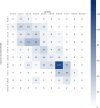Validation of a machine learning approach to estimate expanded disability status scale scores for multiple sclerosis
- PMID: 35755008
- PMCID: PMC9228644
- DOI: 10.1177/20552173221108635
Validation of a machine learning approach to estimate expanded disability status scale scores for multiple sclerosis
Abstract
Background: Disability assessment using the Expanded Disability Status Scale (EDSS) is important to inform treatment decisions and monitor the progression of multiple sclerosis. Yet, EDSS scores are documented infrequently in electronic medical records.
Objective: To validate a machine learning model to estimate EDSS scores for multiple sclerosis patients using clinical notes from neurologists.
Methods: A machine learning model was developed to estimate EDSS scores on specific encounter dates using clinical notes from neurologist visits. The OM1 MS Registry data were used to create a training cohort of 2632 encounters and a separate validation cohort of 857 encounters, all with clinician-recorded EDSS scores. Model performance was assessed using the area under the receiver-operating-characteristic curve (AUC), positive predictive value (PPV), and negative predictive value (NPV), calculated using a binarized version of the outcome. The Spearman R and Pearson R values were calculated. The model was then applied to encounters without clinician-recorded EDSS scores in the MS Registry.
Results: The model had a PPV of 0.85, NPV of 0.85, and AUC of 0.91. The model had a Spearman R value of 0.75 and Pearson R value of 0.74 when evaluating performance using the continuous estimated EDSS and clinician-recorded EDSS scores. Application of the model to eligible encounters resulted in the generation of eEDSS scores for an additional 190,282 encounters from 13,249 patients.
Conclusion: EDSS scores can be estimated with very good performance using a machine learning model applied to clinical notes, thus increasing the utility of real-world data sources for research purposes.
Keywords: Multiple sclerosis; disability evaluation; health services research; machine learning; outcome assessment; registries.
© The Author(s), 2022.
Conflict of interest statement
Declaration of conflicting interests: The authors declared the following potential conflicts of interest with respect to the research, authorship, and/or publication of this article: The authors indicated are employees of OM1, which is involved in issues related to the topic of this manuscript.
Figures




Similar articles
-
Validation of a machine learning approach to estimate Clinical Disease Activity Index Scores for rheumatoid arthritis.RMD Open. 2021 Nov;7(3):e001781. doi: 10.1136/rmdopen-2021-001781. RMD Open. 2021. PMID: 34819386 Free PMC article.
-
Validation of a machine learning approach to estimate Systemic Lupus Erythematosus Disease Activity Index score categories and application in a real-world dataset.RMD Open. 2021 May;7(2):e001586. doi: 10.1136/rmdopen-2021-001586. RMD Open. 2021. PMID: 34016712 Free PMC article.
-
Assessment of Natural Language Processing Methods for Ascertaining the Expanded Disability Status Scale Score From the Electronic Health Records of Patients With Multiple Sclerosis: Algorithm Development and Validation Study.JMIR Med Inform. 2022 Jan 12;10(1):e25157. doi: 10.2196/25157. JMIR Med Inform. 2022. PMID: 35019849 Free PMC article.
-
Mitoxantrone: a review of its use in multiple sclerosis.CNS Drugs. 2004;18(6):379-96. doi: 10.2165/00023210-200418060-00010. CNS Drugs. 2004. PMID: 15089110 Review.
-
Cost of multiple sclerosis by level of disability: a review of literature.Mult Scler. 2005 Apr;11(2):232-9. doi: 10.1191/1352458505ms1137oa. Mult Scler. 2005. PMID: 15794399 Review.
Cited by
-
Natural language processing systems for extracting information from electronic health records about activities of daily living. A systematic review.JAMIA Open. 2024 May 24;7(2):ooae044. doi: 10.1093/jamiaopen/ooae044. eCollection 2024 Jul. JAMIA Open. 2024. PMID: 38798774 Free PMC article. Review.
-
Utilizing Aerobic Capacity Data for EDSS Score Estimation in Multiple Sclerosis: A Machine Learning Approach.Diagnostics (Basel). 2024 Jun 13;14(12):1249. doi: 10.3390/diagnostics14121249. Diagnostics (Basel). 2024. PMID: 38928664 Free PMC article.
-
Detecting New Lesions Using a Large Language Model: Applications in Real-World Multiple Sclerosis Datasets.Ann Neurol. 2025 Aug;98(2):308-316. doi: 10.1002/ana.27251. Epub 2025 Apr 25. Ann Neurol. 2025. PMID: 40277428 Free PMC article.
-
Integrating large language models in care, research, and education in multiple sclerosis management.Mult Scler. 2024 Oct;30(11-12):1392-1401. doi: 10.1177/13524585241277376. Epub 2024 Sep 23. Mult Scler. 2024. PMID: 39308156 Free PMC article. Review.
-
Reply to Letter to the Editor: Machine learning to deal with missing disability status.Mult Scler J Exp Transl Clin. 2022 Oct 20;8(4):20552173221128875. doi: 10.1177/20552173221128875. eCollection 2022 Oct-Dec. Mult Scler J Exp Transl Clin. 2022. PMID: 36311693 Free PMC article. No abstract available.
References
-
- Kurtzke JF. A new scale for evaluating disability in multiple sclerosis. Neurology 1955; 5: 580. - PubMed
-
- Baldassari LE, Salter AR, Longbrake EE, et al.. Streamlined EDSS for use in multiple sclerosis clinical practice: development and cross-sectional comparison to EDSS. Mult Scler 2018; 24: 1347–1355. - PubMed
LinkOut - more resources
Full Text Sources

